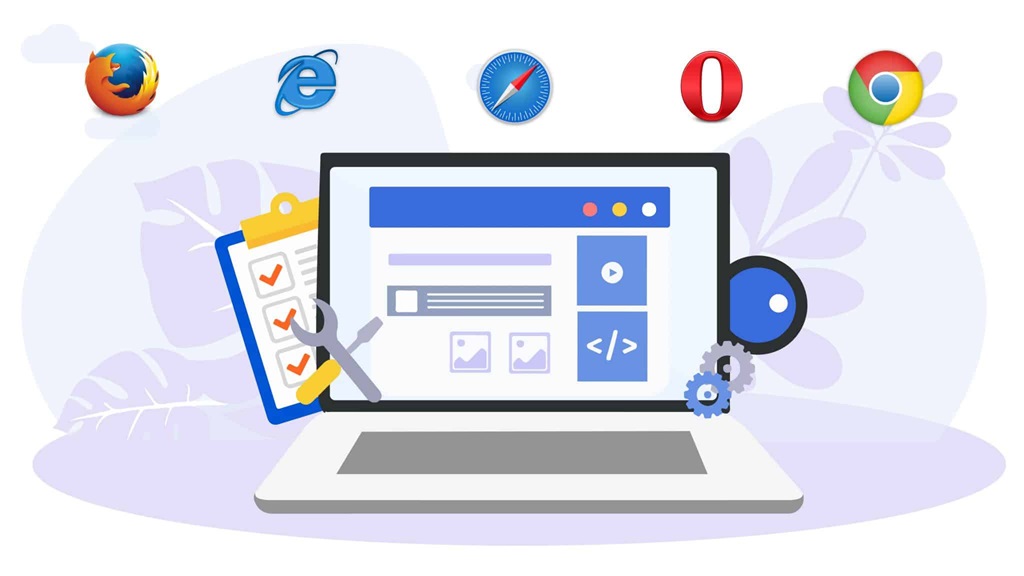In today’s era, the demand for websites is growing very rapidly. Daily, more than 5 lakh websites are being developed and deployed. Overall, there are 1.5 million websites currently deployed and available in the global market. However, only 4 million of these websites are in proper working condition. Why? This is because the issue of browser compatibility causes these websites to fail in terms of functionality. For this, it is highly necessary that proper cross-browser testing is performed to ensure that there are no such issues after deployment. This combination of automation testing and manual testing makes your website much more optimized and performs better. But, what is cross-browser testing, and how to make it a successful one? Let us discuss the details in this article.
Understanding of Cross Browser Testing
One goal of cross-browser testing is to ascertain that a web page or an internet application can perform the way it was supposed to for all devices and browsers. For your website to do this you will be able to spread its reach to the far corners of the earth. It assists in keeping a similar design theme, form, and function all over the panel of different device browsers such as Google Chrome, Mozilla Firefox Safari, etc.
Cross-browser testing is the combination of both- manual as well as automation testing. This helps to ensure a responsive web design on all websites and devices. If you do not want to miss out on any potential customer, then cross-browser testing is a must!
What are the Major Strategies for Cross-Browser Testing?
1.Proper Validation of Codebase
This is the most important stage of cross-browser testing. The validation of code is to ensure that the system is developed following the W3C standards of coding. Long back, Internet Explorer lost its entire market because of this single reason – not following the W3C coding standards. Hence, every developer must follow these guidelines while coding any software program.
Code validation helps to ensure that your website is compatible with multiple browsers and screen sizes, giving a wider reach and consistent functionality for all. With this, you will get the additional benefits of proper search engine optimization, higher traffic on your website, easy maintenance, etc.
For cross-browser compatibility testing, you need to use the code validator tools available online. Moreover, when the developer is coding, he must follow the standard hints and format suggested by text editors like Atom or Visual Studio Code.
2.Don’t Make Your Website Code Structure Complicated
You need to understand that a good developer would implement the best of the features with the least code possible. So, don’t create an overwhelming congestion in the code structure by making additional HTML divisions that you don’t need. Remove all those unnecessary components that might be cluttering the website’s landing page.
If only the necessary components were there, the chances of complications and issues would be much less. If one of the components is misaligned, all the components that are nested within that HTML division will also get misaligned.
3.Don’t Wait for Development’s Completion
This is another necessary step in cross-browser testing. Don’t get stuck in the wheel of achieving perfection. Instead, try to include testing phases in between the development process.
There is a noticeable habit among the coders that they wait for the completion of the entire development phase and only then, dive deep into the testing phase. This is the wrong approach. In this way, the issues keep piling up, and at the end of the day, the entire development process fails in front of the testing team.
Instead, the right way is to test the website at regular intervals. In this way, any issue that is found can be rectified at that very moment, leading to a smoother workflow. Moreover, when you try to correct the code that you have just written, it consumes much less time than if you keep piling it up. In this way, your code performance will improve and there will be much fewer issues in the longer run.
This especially helps in the CSS factor. Suppose, you have built an entire screen with absolute positioning, and the “relative” parent is only coming wrong. In such a situation, you would have to rewrite the entire code, leading to a much-decreased productivity.
4.Use the Latest Optimized Frameworks
Sometimes working hard is not necessary, instead, you need to work smart. If you are building a website, then using raw HTML and CSS, may not be the smartest option. Instead, try to use the already optimized frameworks available in the market. These frameworks resolve the responsibility issues and make your code perform smoothly over all the website browsers.
The main purpose of these frameworks is to ensure that the website user interface seems consistent over all devices and performs smoothly on all screens. This makes the work of the developers a bit easier. A recommended framework for responsiveness in Bootstrap. It provides widgets that are ready to use and responsive across all screen sizes.
5.Integrate the Power of AI-based Testing Tools
It does not matter how hard you try, there will always be certain errors that you cannot fix manually. In those scenarios, AI-powered testing tools can be a rescue. With these tools, you can speed up your testing process, and reduce the time and effort from the QA team.
Sometimes, the testing edge cases that can be missed by the testing team can be fixed with the help of these AI tools. This will give you the ultimate results of cross-browser testing.
How to Implement Cross-Browser Testing?
There are two methods of cross-browser testing: manual and automation testing. Let us check these out in detail below:
Manual Cross-Browser Testing
- Prepare Your Test Plan: First, create a list of browsers and devices you want to test with before doing the actual testing process.
- Open Each Browser: In your PC, open Chrome, Firefox, Safari as well as any other browsers you want to try out.
- Visit Your Website: Input your website’s address into every browser’s address/search bar and press enter to visit your website.
- Check for Consistency: Check the website on different browsers to see how it appears. Watch out for little things such as the design, color schemes, fonts, and functionality. The main aim is to verify that the look is the same in all the devices.
- Test Interactions: Click on links, buttons, and menus to verify that they act correctly in IE11, Edge, and the latest Chrome and Safari browsers online.
- Verify Responsiveness: Resize the window of the browser to check if the website adapts easily to different device displays.
- Take Notes: Write down whatever issues you find out, specifying which browser and version they happened in.
- Repeat for Each Browser: For each of the browsers and devices in your test plan, perform the following steps.
- Fix Issues: When you have found any errors, fix them by working with a website’s code.
- Re-Test: Once the change has been made, repeat the testing procedure to ensure that the problems are not still there.
Automated Cross-Browser Testing
- Choose a Testing Tool: Select a web-based automation testing tool such as Selenium, Cypress, or TestCafe.
- Write Test Scripts: Write scripts for automation testing. These scripts will help reproduce the user interactions on your website.
- Specify Browsers: Arrange your testing tool to do your tests on various browsers and devices.
- Run Tests: Start the computerized testing. The tool will connect each browser, set up required conditions, carry out the actions, and report any problems it encounters while doing so.
- Review Results: Find out the test results to confirm if there are any failures or errors that may have been reported by the testing tool.
- Fix Issues: When this happens, find and correct the defined issues of your website’s code.
- Re-test Codebase: When the issues are fixed, the tester needs to test the code again and confirm that the issues are resolved.
- Continuous Integration: You need to integrate automation testing of cross-browser functionality in your codebase so that the website runs automatically whenever any changes are made in the codebase.
- Monitor the Performance: As you keep adding features to the website, you need to check whether there are any issues in the codebase or not. The monitoring process will help you to give a better user experience.
By following these steps, you can make sure that your website is running properly on all screen sizes and devices.
How To Collaborate in Cross-Browser Testing?
Cross Browser testing is not the result of one individual’s efforts. Instead, it demands proper collaboration of developers, designers, and quality testing teams together. The first role is that of the developers to write clean and optimized code. Then, the design team verifies whether the deployed codebase matches the visual features that were asked initially.
Then, the testers come into play and help to find out and document the issues. Here, a proper collaboration can only lead to the correct deployment in the future. Along with these, sometimes, the clients are also asked to check out the developed product and find out the issues that can feel as a user.
Final Words
By now, you have understood what cross-browser testing is and how to implement it in real projects. Remember, that proper cross-browser testing is extremely important if you wish to get a uniform result on all the screens. Overall, it is not just about compatibility; it is about delivering a consistent user experience across different browsers and devices. While implementing cross-browser testing, leveraging a robust platform like LambdaTest can greatly enhance your testing process. LambdaTest is a cross-browser testing platform that offers a comprehensive suite of features for various testing procedures, including live interactive testing, automated testing, responsive testing, and more. Users can perform these across a range of devices and operating systems combined thus ensuring maximum compatibility and usability for the end-user. Overall, utilizing LambdaTest will help you streamline your cross-browser testing efforts while accelerating your Agile development cycles, and ultimately delivering high-quality products to your end-users.


